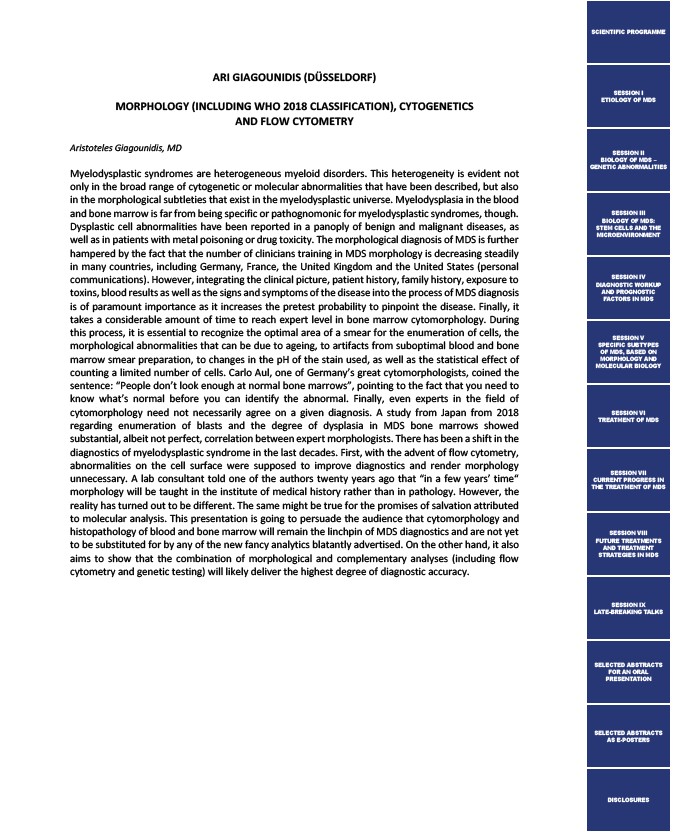
ARI GIAGOUNIDIS (DÜSSELDORF)
MORPHOLOGY (INCLUDING WHO 2018 CLASSIFICATION), CYTOGENETICS
AND FLOW CYTOMETRY
Aristoteles Giagounidis, MD
Myelodysplastic syndromes are heterogeneous myeloid disorders. This heterogeneity is evident not
only in the broad range of cytogenetic or molecular abnormalities that have been described, but also
in the morphological subtleties that exist in the myelodysplastic universe. Myelodysplasia in the blood
and bone marrow is far from being specific or pathognomonic for myelodysplastic syndromes, though.
Dysplastic cell abnormalities have been reported in a panoply of benign and malignant diseases, as
well as in patients with metal poisoning or drug toxicity. The morphological diagnosis of MDS is further
hampered by the fact that the number of clinicians training in MDS morphology is decreasing steadily
in many countries, including Germany, France, the United Kingdom and the United States (personal
communications). However, integrating the clinical picture, patient history, family history, exposure to
toxins, blood results as well as the signs and symptoms of the disease into the process of MDS diagnosis
is of paramount importance as it increases the pretest probability to pinpoint the disease. Finally, it
takes a considerable amount of time to reach expert level in bone marrow cytomorphology. During
this process, it is essential to recognize the optimal area of a smear for the enumeration of cells, the
morphological abnormalities that can be due to ageing, to artifacts from suboptimal blood and bone
marrow smear preparation, to changes in the pH of the stain used, as well as the statistical effect of
counting a limited number of cells. Carlo Aul, one of Germany’s great cytomorphologists, coined the
sentence: “People don’t look enough at normal bone marrows”, pointing to the fact that you need to
know what’s normal before you can identify the abnormal. Finally, even experts in the field of
cytomorphology need not necessarily agree on a given diagnosis. A study from Japan from 2018
regarding enumeration of blasts and the degree of dysplasia in MDS bone marrows showed
substantial, albeit not perfect, correlation between expert morphologists. There has been a shift in the
diagnostics of myelodysplastic syndrome in the last decades. First, with the advent of flow cytometry,
abnormalities on the cell surface were supposed to improve diagnostics and render morphology
unnecessary. A lab consultant told one of the authors twenty years ago that “in a few years’ time“
morphology will be taught in the institute of medical history rather than in pathology. However, the
reality has turned out to be different. The same might be true for the promises of salvation attributed
to molecular analysis. This presentation is going to persuade the audience that cytomorphology and
histopathology of blood and bone marrow will remain the linchpin of MDS diagnostics and are not yet
to be substituted for by any of the new fancy analytics blatantly advertised. On the other hand, it also
aims to show that the combination of morphological and complementary analyses (including flow
cytometry and genetic testing) will likely deliver the highest degree of diagnostic accuracy.
SCIENTIFIC PROGRAMME
SESSION I
ETIOLOGY OF MDS
SESSION II
BIOLOGY OF MDS –
GENETIC ABNORMALITIES
SESSION III
BIOLOGY OF MDS:
STEM CELLS AND THE
MICROENVIRONMENT
SESSION IV
DIAGNOSTIC WORKUP
AND PROGNOSTIC
FACTORS IN MDS
SESSION V
SPECIFIC SUBTYPES
OF MDS, BASED ON
MORPHOLOGY AND
MOLECULAR BIOLOGY
SESSION VI
TREATMENT OF MDS
SESSION VII
CURRENT PROGRESS IN
THE TREATMENT OF MDS
SESSION VIII
FUTURE TREATMENTS
AND TREATMENT
STRATEGIES IN MDS
SESSION IX
LATE-BREAKING TALKS
SELECTED ABSTRACTS
FOR AN ORAL
PRESENTATION
SELECTED ABSTRACTS
AS E-POSTERS
DISCLOSURES